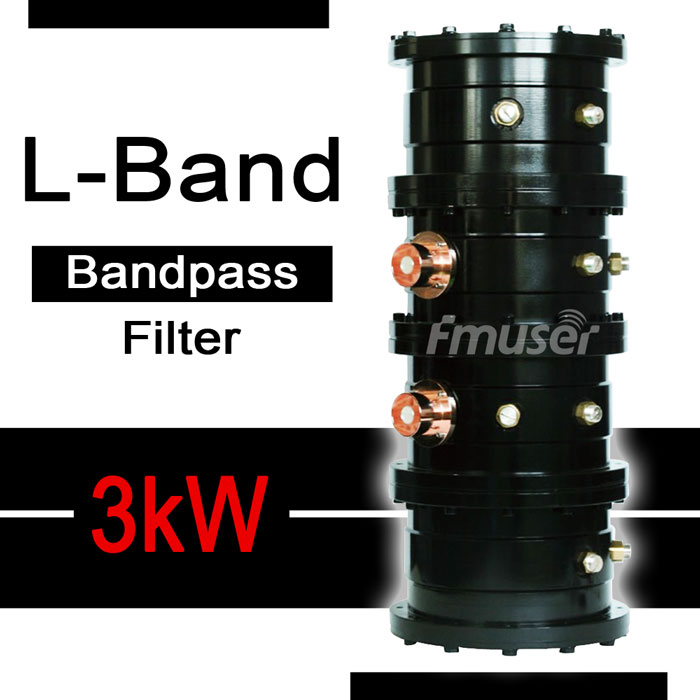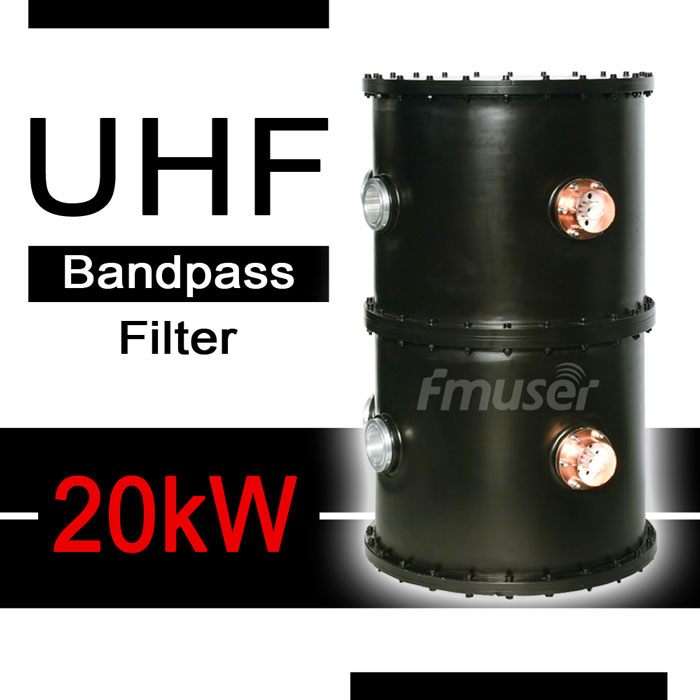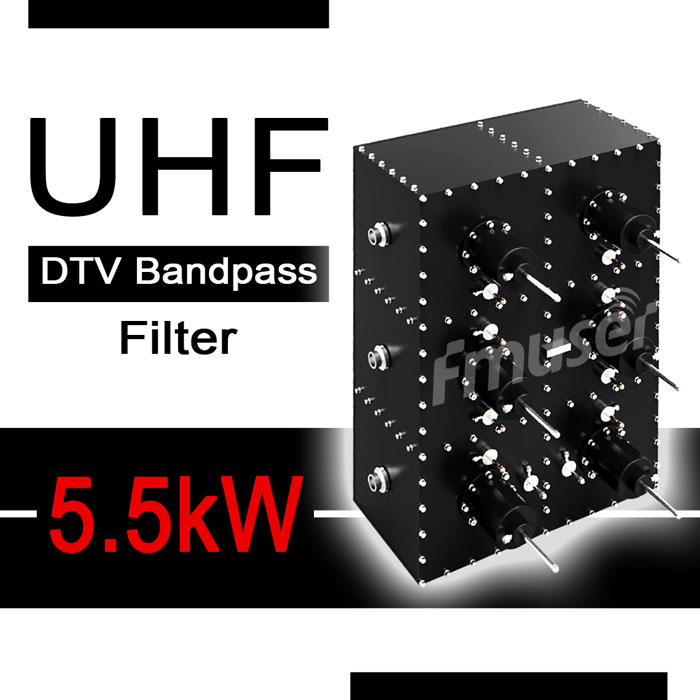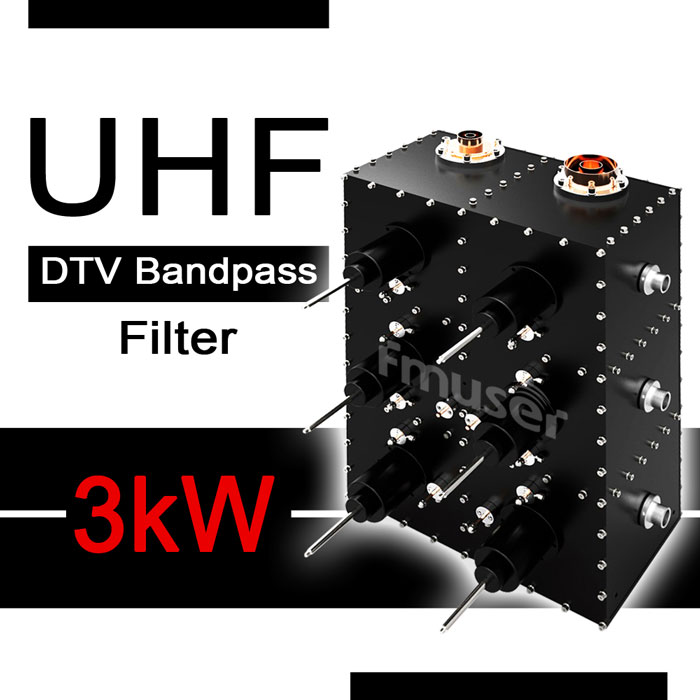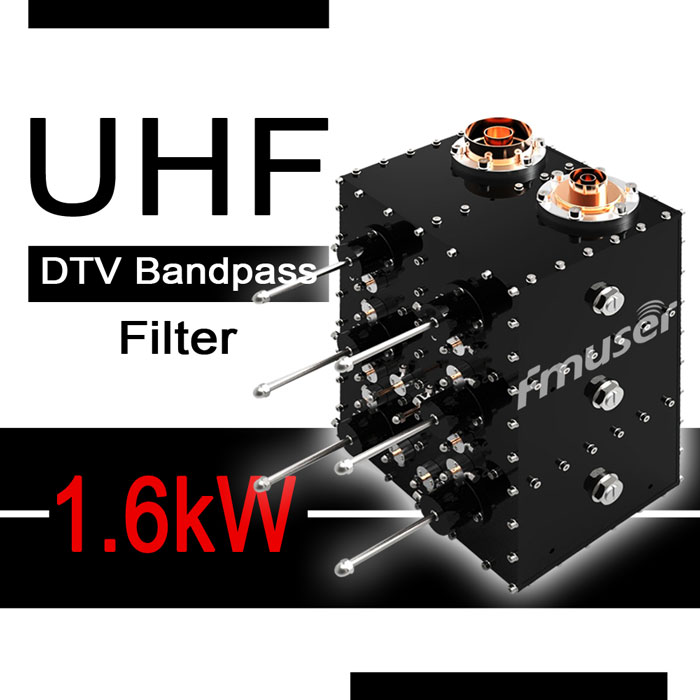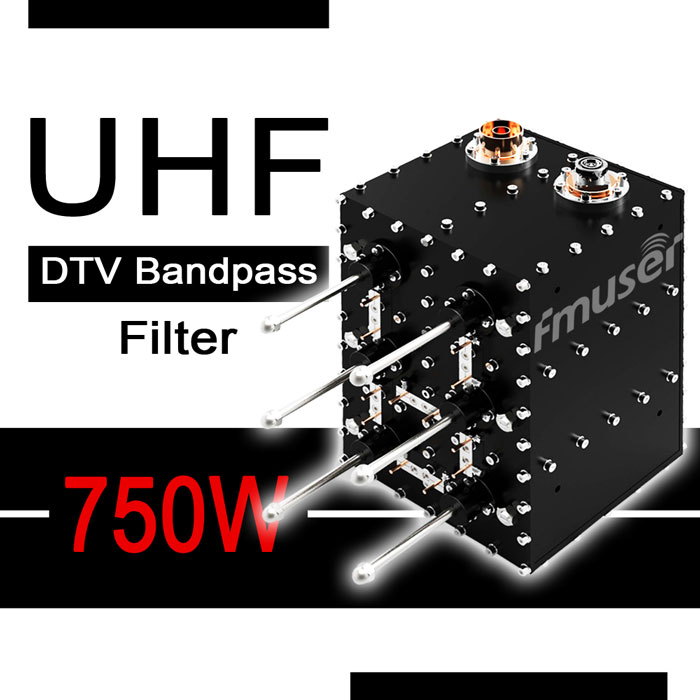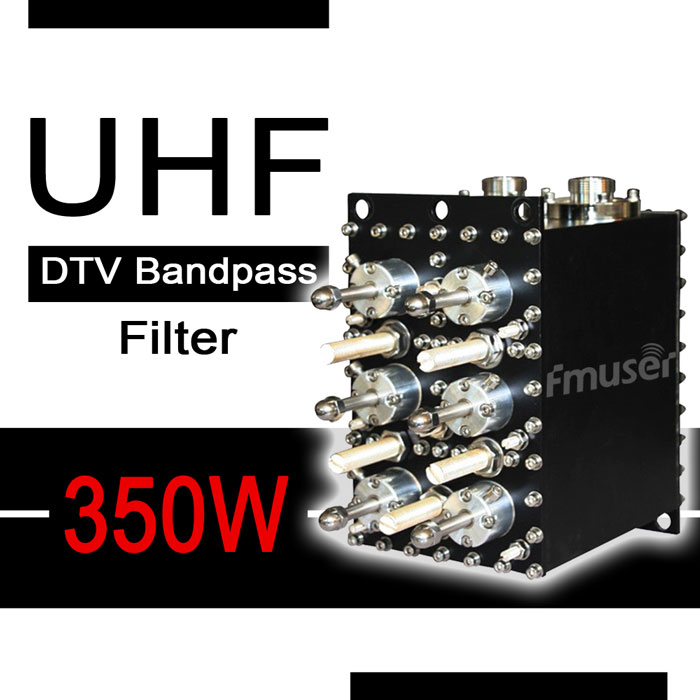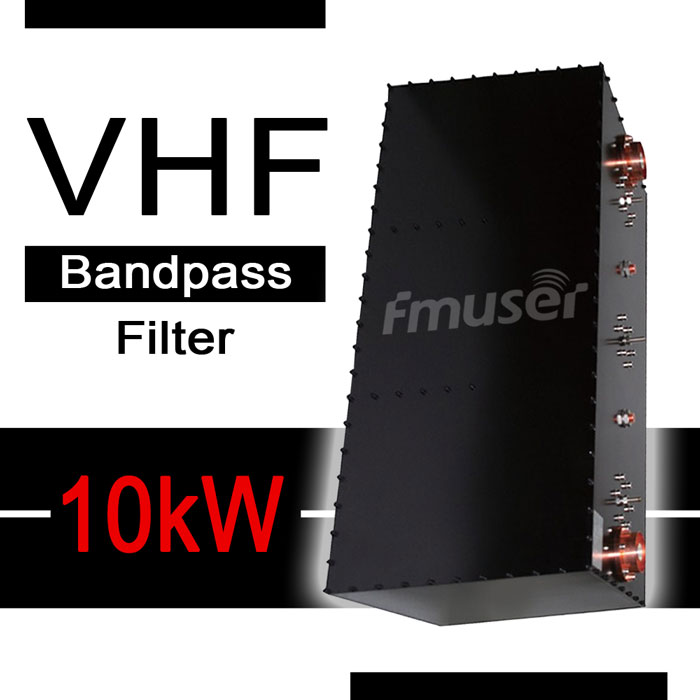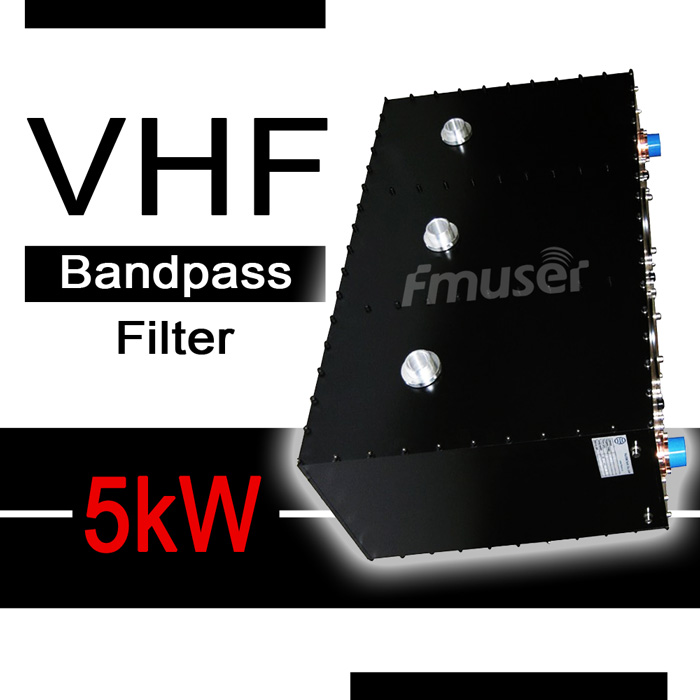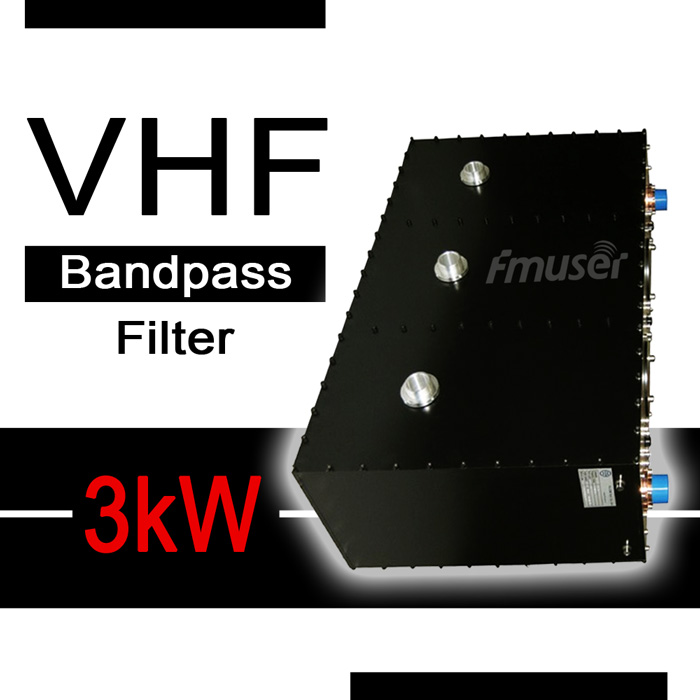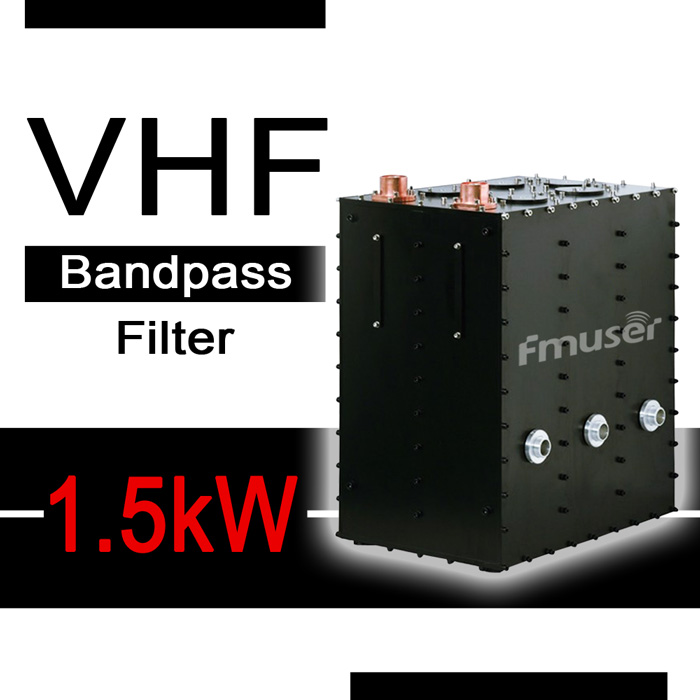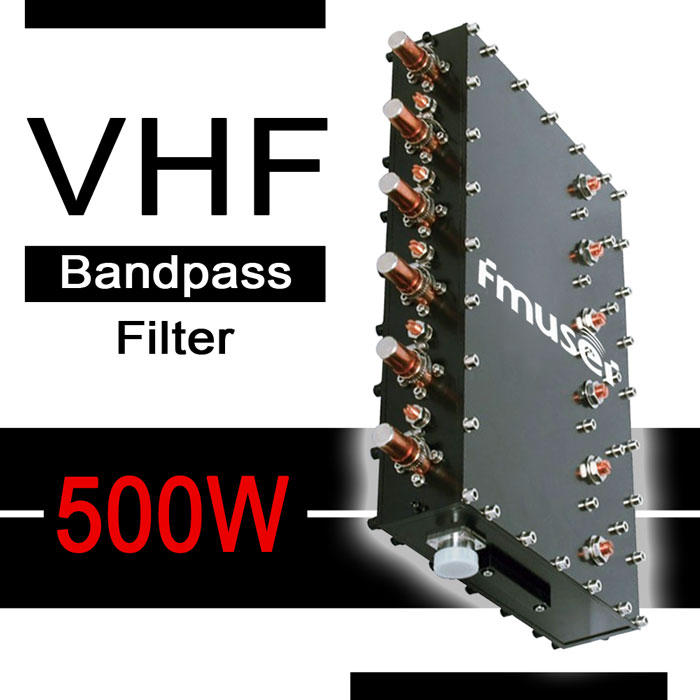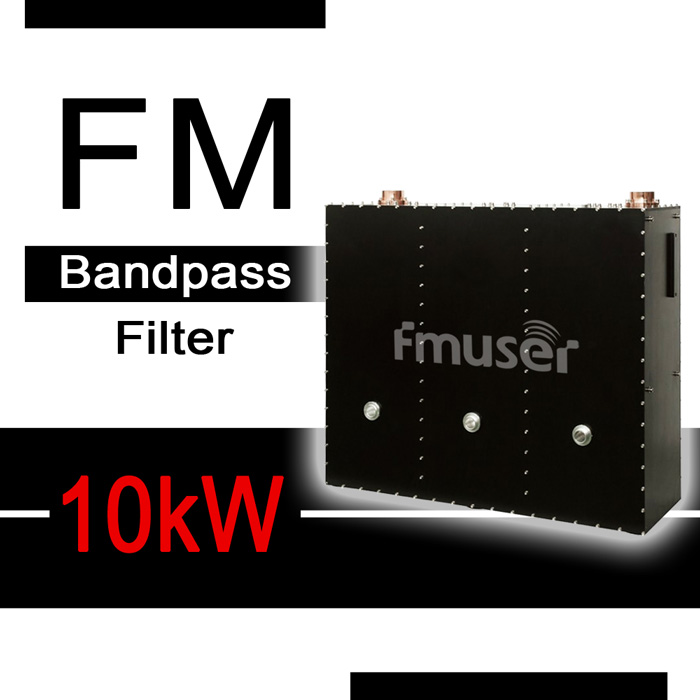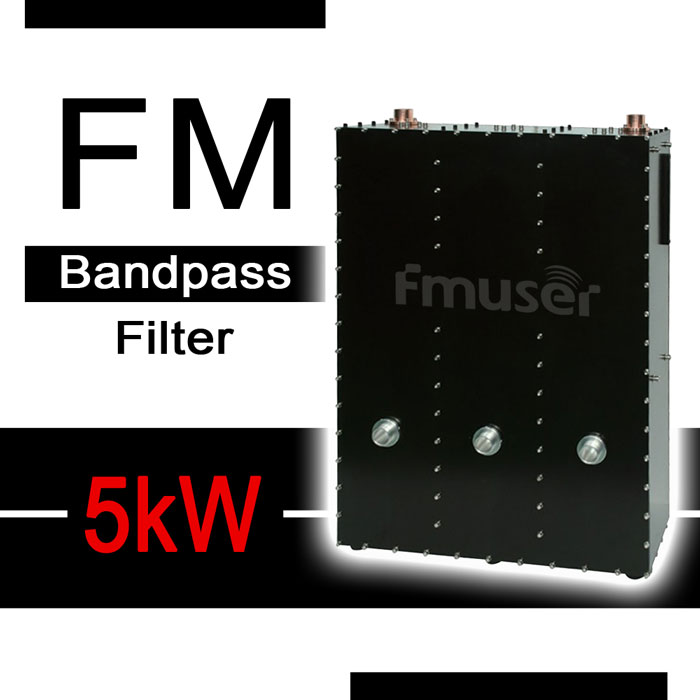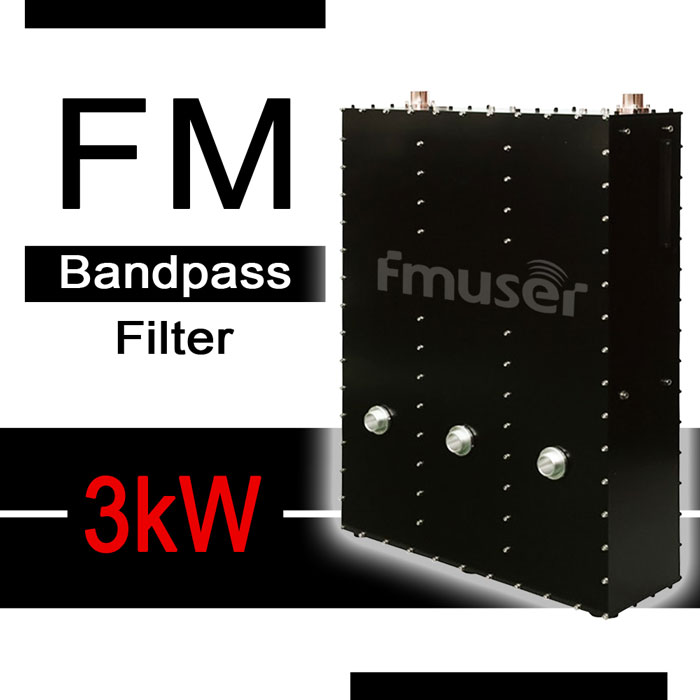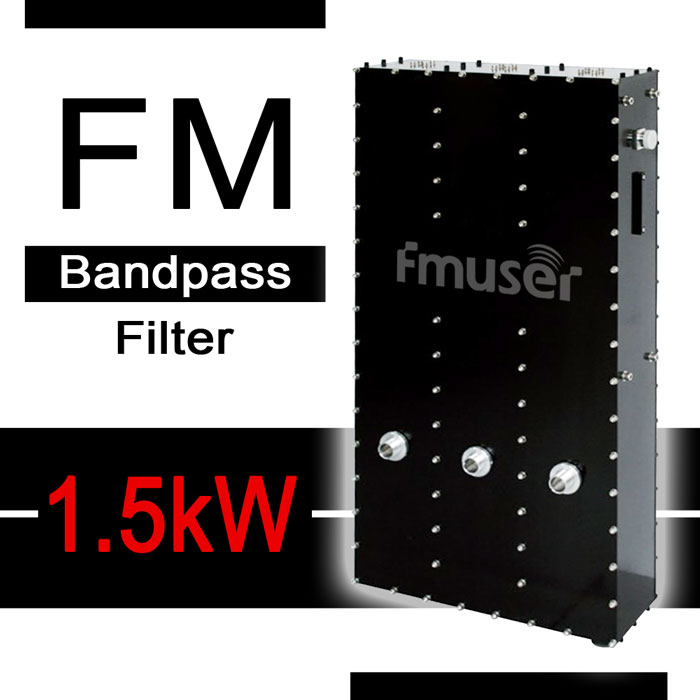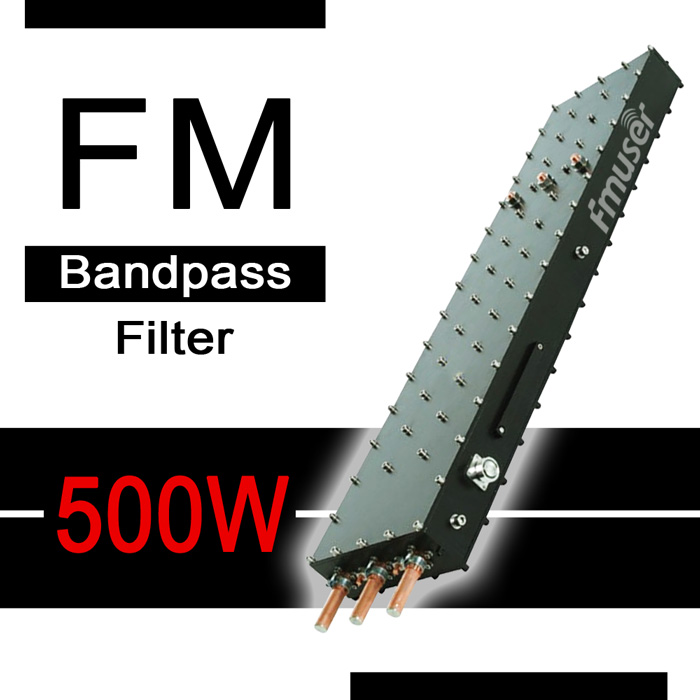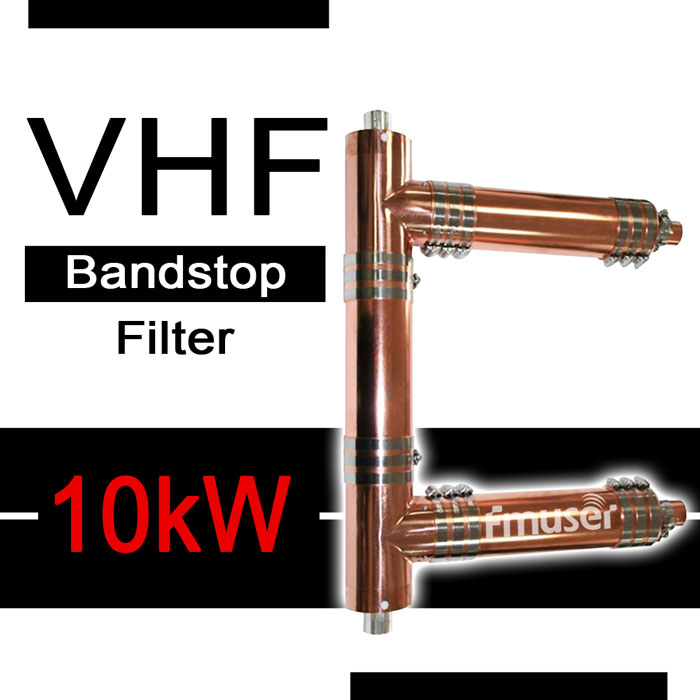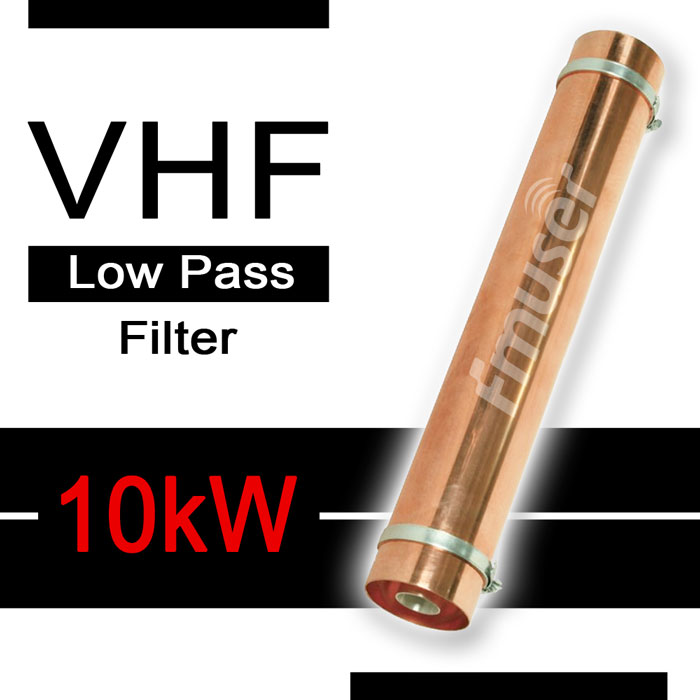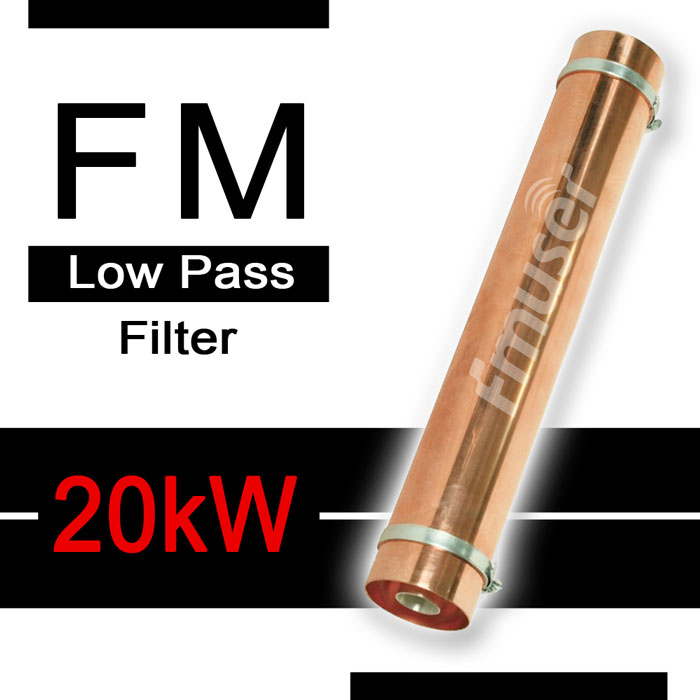
RF Cavity Filters
Where to Buy Low Pass Filter for Radio Station?

FMUSER has been one of the leading radio studio equipment suppliers for nearly half a century. Since 2008, FMUSER has created a working environment that fosters creative collaboration between staff of highly skilled engineering developers and a meticulous manufacturing team. Through this spirit of and dedication to true collaboration, FMUSER has been able to create some of the most innovative electronic assemblies, utilizing the time-tested principles of yesterday and incorporating the advanced science of today. One of our proudest achievements, as well as a popular choice of our many clients, is our RF low pass filter for the radio station.
"If you're looking for professional radio station equipment for sale, why not select one of those best broadcasting studio equipment from FMUSER? They cover all ranges of the radiofrequency filter assemblies, some of them are essential for the radio station, for example, the FM low pass filter, along with many HPF for sale, BPF for sale, BSF for sale, and low pass cavity filters for sale such as the 88-108Mhz low pass filter for sale. UHF and VHF filter such as UHF bandpass filter and VHF bandpass filter, and of course, they also have high quality radio studio equipment for sale."
- - - - - James, loyal member of FMUSER
The Next Part is Why RF Low Power Filters are Needed? | Skip
What We Bring You in This Page with
FMUSER 20kW FM Low Pass Filter Works Well In:
- Professional FM radio stations at provincial, municipal, and township levels
- Medium and large FM radio stations with ultra-wide coverage
- Professional FM radio station with over millions of audience
- Radio station operators who need complete radio turnkey solutions at a low cost
Thanks to the world-class factory, FMUSER, as a leading manufacturer of broadcast equipment sales, has successfully served all kinds of customers by providing complete broadcast solutions for over 10 years, one thing is sure that is a high power lowpass filter with 2nd and 3rd harmonics filtering is usually employed to combine and isolate wireless radio signals from multiple FM radio transmitters.
"Cannot say FMUSER is the best radio station equipment supplier in the world, but for some of the radio station operators, yes, FMUSER is indeed a reliable supplier and manufacturer of radio station equipment."
- - - - - Peter, loyal member of FMUSER
▲ Where to Buy the Best FM Low Pass Filter ▲
▲ Back to Content ▲
Why RF Low Power Filters are Needed for the Radio Station?
The Previous Part is Where to Buy the Best FM Low Pass Filter | Skip
The Next Part is How do Annoying Harmonic and Spurious Emissions Occur | Skip
An Essential Part of Radio Station Equipment
Here are few reasons why RF low pass filters are necessary for the radio broadcast industry:
- Harmonics and spurious emission cannot be avoided, and they will affect radio stations in different radio frequency bands and reduce the quality of radio programs and that's the core value of a coaxial low pass filter to the radio station.
- If you do not use a professional RF low pass filter, you are likely to be punished by the local radio management department (such as FCC) for generating massive radio interference, for example, numbers of unwanted harmonics and spurious emissions generated by your FM and TV transmitter
- Radio transmitters use high power frequency low pass filters to prevent harmonic emissions that may interfere with other communications.
- To suppress FM station transmitter harmonics: FM transmitters usually produce harmonics - multiples of transmitter frequency. Some of them result in interference with VHF-tv and UHF-tv reception and paging and cellular radio reception. This series of high power low pass filters pass through the whole FM frequency band with low loss and provide a lot of harmonic suppression.
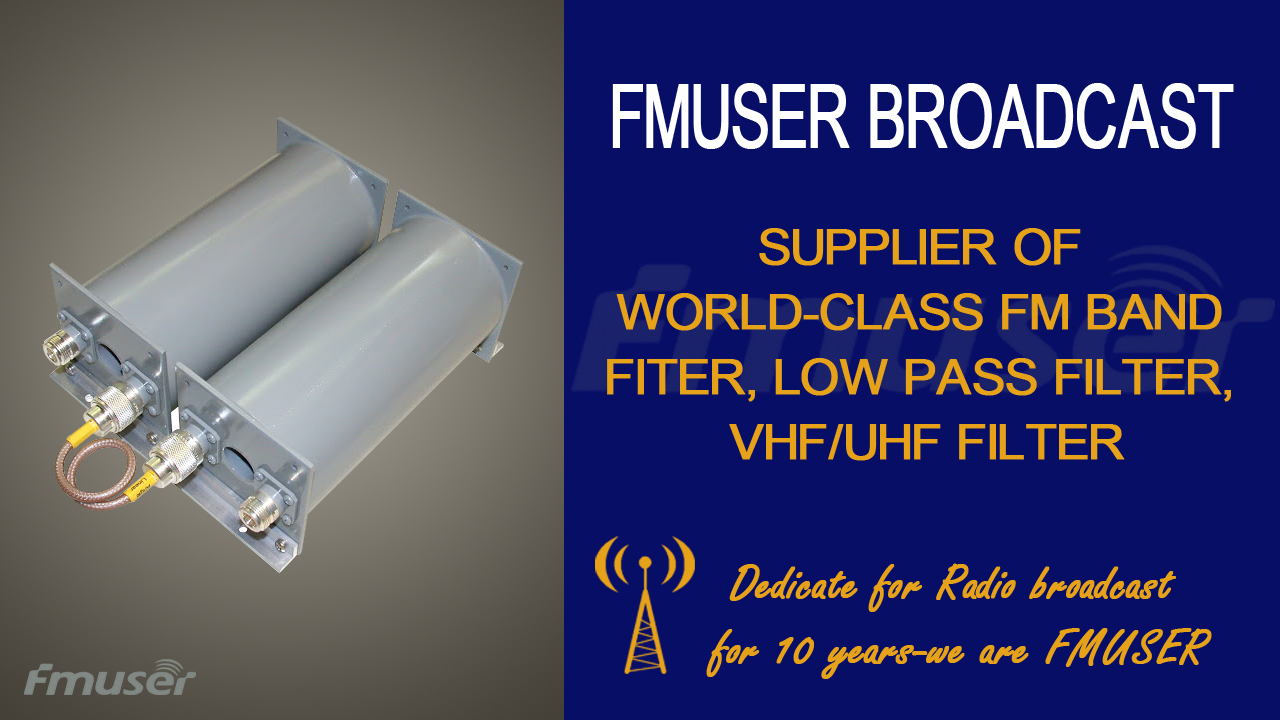
Buy RF Harmonics Filter from FMUSER Broadcast
The greatest value of the RF Harmonics filter is to help radio stations select the required signals for use. Especially for large radio stations, how to provide the audience with the highest quality radio programs without being punished by the local radio management is the prerequisite to enhance the competitiveness of radio peers and improve the brand awareness of radio stations
FMUSER offers harmonic filters such as the 20kW FM low pass filter for transmitter power levels up to 20 kW. A unique design provides 45 dB or greater rejection from the second to the tenth harmonic and beyond. This yields filters with overall lengths 30% to 50% shorter than typical FM harmonic filters.
We have the best RF filters for sale, buy RF filters that power ranging from 500W to 1000W from FMUSER! Specifically, they are 20kW FM low pass filter for sale (LPF) and 10kW VHF low pass filters for sale (LPF), 10kW VHF bandstop filter for sale (BSF), 350W UHF digital bandpass filter for sale, and one of our top-sale radio station equipment - FM bandpass filters for sale.
You may find all you need if you keep exploring, we have FM bandpass filters that power ranging from 500W to 1kW, specifically, they are 500W, 1500W, 3000W, 5000W, 10000W FM bandpass filters which are specially designed for FM radio stations. Besides, customization is available for harmonics filters, all they are with budget cost and amazing quality, ask us for support, we're all ears!
As one of the most important broadcasting assemblies of FM / TV radio stations, the RF cavity filter is as necessary as the FM / UHF / VHF combiner, radio broadcasting transmitter, transmitting antenna, and other similar broadcasting station equipment. It is no exaggeration to say that as the core product of RF passive products, filters are actually more important than any other passive assemblies in repeaters and base stations.
Still, the RF filter, for example, the low pass RF filter, is a necessary device on the transmitting side of the broadcasting station to suppress the harmonics generated by the transmitter. This is because RF system operators all over the world use different frequencies, so there are quite a lot of messy signals waving in the air, some of them are for television, military, others are for weather research and other purposes.
▲ Why RF Filters are Needed for the Radio Station ▲
▲ Back to Content ▲
How do Annoying Harmonic and Spurious Emissions Occur?
The Previous Part is Why Low Pass RF Filters are Needed | Skip
The Next Part is Best RF Harmonics Filter for Sale | Skip
What bothers all RF engineers is that harmonic and spurious emissions cannot be avoided. For radio station operators, it is very important to understand what harmonics and spurious emissions are, or how they are generated and how to reduce their impact.
At the same time, it is also beneficial to control the quality of radio station programs, FMUSER's professional RF technical team explained to us some theoretical knowledge about harmonics and spurious emission.
If you want to further understand why radio stations need professional RF filters, you may need the following contents
How are Harmonics Generated?
Frequencies that occur at an exact multiple of the input frequency are called harmonics. In other words, harmonics are unwanted transmission, which is a multiple of the expected transmission frequency. This unwanted transmission occurs at a lower power level than the desired transmission.
As we all know, there is an indispensable equipment in radio stations, that is, radio transmitters. Whether 1kW or 10kW transmitter will be specially designed, and the basic RF component of the transmitter is equipped with a band-pass filter, but almost every RF transmitter will produce some harmonics, Even the most professional wireless transmitter can not avoid all clutter and stray emission
Harmonics are also considered to be a potential cause of RF interference. Some waveforms, such as square waves, sawtooth waves,s, and triangular waves, contain a lot of energy at the harmonic frequency.
How are Spurious Emission Generated?
Unlike harmonics, spurious emission does not occur when the input frequency is doubled; They didn't spread it on purpose. Spurious emission is an accidental emission, commonly known as splash. They are the result of intermodulation, electromagnetic interference, frequency conversion, or harmonics.
▲ How do Annoying Harmonic and Spurious Emissions Occur ▲
▲ Back to Content ▲
Best RF Low Power Filter for Sale
The Previous Part is How Harmonics and Spurious Emissions Occur | Skip
The Next Part is How to Choose the Best FM Harmonics Filter | Skip
You Need This Low Pass RF Filter More Than Ever
We all know that the radio transmitters use low pass RF filters to prevent harmonics and spurious emissions that may interfere with other communications, while most FM transmitters generate harmonics even on tens of times of the fundamental frequency.
Fortunately, FMUSER 20kW FM low pass filter is one of the best RF system filtering assemblies for the FM broadcast frequency band. In order to help decrease the impact brought by the harmonics and spurious emission, FMUSER hereby presents one of our proud harmonic filters-the 20kW RF low pass filter for FM radio station.
Low Pass RF Filter Designed Only For the Best Quality
If you don't want those unwanted harmonics to fall in the frequency band irrelevant to you and cause serious interference (you may receive a bunch of troublesome complaint letters and get punished by some regulatory agencies), for example, the frequencies of TV channels or other radio stations. Using FMUSER 20kW RF low pass filter is the best way to help you free from those annoying harmonics and troublesome complaint letters.

- Extraordinary Harmonics Filtering Ability
The biggest feature of this high power low pass filter is its harmonic attenuation ability - according to the reliable test data of FMUSER's test team, the second harmonic attenuation and higher harmonic attenuation of this 20kW low pass RF filter have reached respectively ≥ 35 dB and ≥ 60 dB, which is quite a strong harmonics filtering capacity for the radio station.
- Extra-Low Insertion Loss
The low insertion loss of FMUSER's 20kW FM low pass filter makes it suitable for power levels up to 20000 watts, which means that with this amazing RF filter, you're able to combine using a variety of radio transmitters with different powers in the radio station, and the audience can obtain the radio programs with the highest quality and considerably low harmonics! Connector: 3 1 / 8 "maximum input power 20kw
- Best User Experience
The 20kW Low Pass filters for sale, built-in with an easy connecting system, are specially built for FM Radio Station. Considering the best user experience, the filter system enables easy integration into the FM transmitters.
FMUSER offers a complete line of the FM and UHF/VHF Filters for harmonics suppression in radio broadcast stations.
Globally speaking, we'd love to help radio stations operator from all over the world to isolate closely spaced FM transmitters, we notice that some of them show great interest in combining multiple FM frequencies on one master antenna, others would like to have custom applications for their multiple transmitters in their stations. 20kW FM low pass filter, for example, is one of our best-sales FM harmonics filters used for combing FM radio transmitters power up to 20kW, you may see this big guy in some large FM radio stations.
WE ARE ALWAYS LISTENING TO YOUR NEEDS if you're interested in one of our top-sale RF harmonics filters.
Guess You Need More Than What You See
As we mentioned above, we're one of the best radio station equipment manufacturers in the global area, besides the 20kW low pass RF filter, you may also meet other top-sale RF filters in the following content. Well, good quality and budget cost as always.
Chart A. FM/VHF LPF Low Pass Filter for Sale
The Next is 10kW VHF Bandreject Filter VHF BSF Bandstop Filter for Sale | Skip
| Classification | Model | Max. Input Power | VSWR |
Frequency range |
Attenuation |
2nd harmonic |
3rd harmonic |
Connectors | Visit for More |
| FM | A | 20 kW |
≤ 1.1 |
87 - 108 MHz |
≥ 35 dB |
≥ 60 dB |
3 1/8" |
More | |
| VHF | B | 10 kW |
≤ 1.1 |
167 - 223 MHz |
≥ 35 dB |
≥ 60 dB |
3 1/8" |
More |
Chart B. 10kW VHF BSF Bandstop Bandreject Filter for Sale
The Previous is FM/VHF LPF Low Pass Filter for Sale | Skip
The Next is 350W UHF DTV BPF Bandpass Filter for Sale | Skip
| Classification | Model | Max. Input Power | VSWR | fv | f0±4MHz |
Frequency range |
Attenuation |
fv-4.43±0.2MHz |
Connectors | Visit for More |
| VHF | A | 10 kW | ≤ 1.1 |
≤ 1.1 |
167 - 223 MHz |
≥ 20 dB |
3 1/8" | More |
Chart C. 350W UHF DTV BPF Bandpass Filter for Sale
The Previous is 10kW VHF BSF Bandstop Bandreject Filter for Sale | Skip
The Next is FM BPF Bandpass Filter for Sale | Skip
| Classification | Model | Max. Input Power | Cavities | VSWR | Insertion Loss | f0 |
f0±3.8MHz |
f0±4.2MHz |
f0±6MHz |
f0±12MHz |
Visit for More | |
| UHF |
A |
350W |
6 |
≤ 1.15 |
474 MHz |
≤ 0.50 dB |
≤ 1.3 dB |
≥ 8 dB |
≥ 20 dB |
≥ 40 dB |
More | |
|
858 MHz |
≤ 0.60 dB |
≤ 1.65 dB |
≥ 8 dB |
≥ 20 dB |
≥ 40 dB |
More |
Chart D. FM BPF Bandpass Filter for Sale
The Previous is 350W UHF DTV BPF Bandpass Filter for Sale | Skip
The Next is VHF BPF Bandpass Filter for Sale | Skip
| Classification | Model | Max. Input Power | Cavities | VSWR |
Frequency range |
Insertion Loss |
f0 |
f0±300kHz |
f0±2MHz |
f0±4MHz |
Connectors | Visit for More |
| FM | A | 500W |
3 |
≤ 1.1 |
87 - 108 MHz |
≤ 0.70 dB |
≤ 0.75 dB |
≥ 25 dB |
≥ 40 dB |
7-16 DIN |
More | |
| FM | A1 | 500W |
4 |
≤ 1.1 |
87 - 108 MHz |
≤ 1.10 dB |
≤ 1.20 dB |
≥ 40 dB |
≥ 60 dB |
7-16 DIN |
More | |
| FM | A |
1500W 1.5kW |
3 |
≤ 1.1 |
87 - 108 MHz |
Insertion Loss |
≤ 0.30 dB |
≤ 0.35 dB |
≥ 25 dB |
≥ 40 dB |
7-16 DIN |
More |
| FM | A1 |
1500W 1.5kW |
4 |
≤ 1.1 |
87 - 108 MHz |
≤ 0.50 dB |
≤ 0.60 dB |
≥ 40 dB |
≥ 60 dB |
7-16 DIN |
More | |
| FM | A |
3000W 3kW |
3 |
≤ 1.1 |
87 - 108 MHz |
Insertion Loss |
≤ 0.25 dB |
≤ 0.30 dB |
≥ 25 dB |
≥ 40 dB |
1 5/8" |
More |
| FM | A1 |
3000W 3kW |
4 |
≤ 1.1 |
87 - 108 MHz |
≤ 0.40 dB |
≤ 0.45 dB |
≥ 40 dB |
≥ 60 dB |
1 5/8" |
More | |
| FM | A |
5000W 5kW |
3 |
≤ 1.1 |
87 - 108 MHz |
Insertion Loss |
≤ 0.20 dB |
≤ 0.25 dB |
≥ 25 dB |
≥ 40 dB |
1 5/8" |
More |
| FM | A1 |
5000W 5kW |
4 |
≤ 1.1 |
87 - 108 MHz |
≤ 0.35 dB |
≤ 0.40 dB |
≥ 40 dB |
≥ 60 dB |
1 5/8" |
More | |
| FM | A |
10000W 10kW |
3 |
≤ 1.1 |
87 - 108 MHz |
Insertion Loss |
≤ 0.15 dB |
≤ 0.15 dB |
≥ 25 dB |
≥ 40 dB |
3 1/8" |
More |
| FM | A1 |
10000W 10kW |
4 |
≤ 1.1 |
87 - 108 MHz |
≤ 0.25 dB |
≤ 0.30 dB |
≥ 40 dB |
≥ 60 dB |
3 1/8" |
More |
Chart E. VHF BPF Bandpass Filter for Sale
The Previous is FM BPF Bandpass Filter for Sale | Skip
Back to FM/VHF LPF Low Pass Filter for Sale | Skip
| Classification | Model | Max. Input Power | Cavities | VSWR |
Frequency range |
Insertion Loss |
f0 |
f0±300kHz |
f0±2MHz |
f0±4MHz |
Connectors | Visit for More |
| VHF | A | 500W |
4 |
≤ 1.1 |
167 - 223 MHz |
≤ 0.40 dB |
≤ 0.50 dB |
≥ 20 dB |
≥ 35 dB |
7-16 DIN |
More | |
| VHF | A1 | 500W |
6 |
≤ 1.1 |
167 - 223 MHz |
≤ 0.80 dB |
≤ 1.00 dB |
≥ 50 dB |
≥ 70 dB |
7-16 DIN |
More | |
| VHF | A |
1500W 1.5kW |
4 |
≤ 1.1 |
167 - 223 MHz |
Insertion Loss |
≤ 0.15 dB |
≤ 0.20 dB |
≥ 20 dB |
≥ 35 dB |
1 5/8" |
More |
| VHF | A1 |
1500W 1.5kW |
6 |
≤ 1.1 |
167 - 223 MHz |
≤ 0.25 dB |
≤ 0.30 dB |
≥ 50 dB |
≥ 70 dB |
1 5/8" |
More | |
| VHF | A |
3000W 3kW |
3 |
≤ 1.1 |
167 - 223 MHz |
Insertion Loss |
≤ 0.10 dB |
≤ 0.15 dB |
≥ 10 dB |
≥ 20 dB |
1 5/8" |
More |
| VHF | A1 |
3000W 3kW |
4 |
≤ 1.1 |
167 - 223 MHz |
≤ 0.20 dB |
≤ 0.25 dB |
≥ 20 dB |
≥ 35 dB |
1 5/8" |
More | |
| VHF | A |
5000W 5kW |
3 |
≤ 1.1 |
167 - 223 MHz |
Insertion Loss |
≤ 0.10 dB |
≤ 0.10 dB |
≥ 10 dB |
≥ 20 dB |
1 5/8" |
More |
| VHF | A1 |
5000W 5kW |
4 |
≤ 1.1 |
167 - 223 MHz |
≤ 0.15 dB |
≤ 0.20 dB |
≥ 20 dB |
≥ 35 dB |
1 5/8" |
More | |
| VHF | A |
10000W 5kW |
3 |
≤ 1.1 |
167 - 223 MHz |
Insertion Loss |
≤ 0.10 dB |
≤ 0.10 dB |
≥ 10 dB |
≥ 20 dB |
3 1/8" |
More |
| VHF | A1 |
10000W 5kW |
4 |
≤ 1.1 |
167 - 223 MHz |
≤ 0.15 dB |
≤ 0.20 dB |
≥ 20 dB |
≥ 35 dB |
3 1/8" |
More |
Buy RF Harmonics Filter for Radio Station? Here is the Right Place!
FMUSER is one of the best RF filter manufacturers who produce harmonics Filter for sale in near 200+ countries and regions around the world, here are the suggested countries from which you may make reference.
Afghanistan, Albania, Algeria, Andorra, Angola, Antigua and Barbuda, Argentina, Armenia, Australia, Austria, Azerbaijan, The Bahamas, Bahrain, Bangladesh, Barbados, Belarus, Belgium, Belize, Benin, Bhutan, Bolivia, Bosnia and Herzegovina, Botswana, Brazil, Brunei, Bulgaria, Burkina Faso, Burundi, Cabo Verde, Cambodia, Cameroon, Canada, Central African Republic, Chad, Chile, China, Colombia, Comoros, Congo, Democratic Republic of the, Congo, Republic of the, Costa Rica, Côte d’Ivoire, Croatia, Cuba, Cyprus, Czech Republic, Denmark, Djibouti, Dominica, Dominican Republic, East Timor (Timor-Leste), Ecuador, Egypt, El Salvador, Equatorial Guinea, Eritrea, Estonia, Eswatini, Ethiopia, Fiji, Finland, France, Gabon, The Gambia, Georgia, Germany, Ghana, Greece, Grenada, Guatemala, Guinea, Guinea-Bissau, Guyana, Haiti, Honduras, Hungary, Iceland, India, Indonesia, Iran, Iraq, Ireland, Israel, Italy, Jamaica, Japan, Jordan, Kazakhstan, Kenya, Kiribati, Korea, North, Korea, South, Kosovo, Kuwait, Kyrgyzstan, Laos, LATVia, Lebanon, Lesotho, Liberia, Libya, Liechtenstein, Lithuania, Luxembourg, Madagascar, Malawi, Malaysia, Maldives, Mali, Malta, Marshall Islands, Mauritania, Mauritius, Mexico, Micronesia, Federated States of, Moldova, Monaco, Mongolia, Montenegro, Morocco, Mozambique, Myanmar (Burma), Namibia, Nauru, Nepal, Netherlands, New Zealand, Nicaragua, Niger, Nigeria, North Macedonia, Norway, Oman, Pakistan, Palau, Panama, Papua New Guinea, Paraguay, Peru, Philippines, Poland, Portugal, Qatar, Romania, Russia, Rwanda, Saint Kitts and Nevis, Saint Lucia, Saint Vincent and the Grenadines, Samoa, San Marino, Sao Tome and Principe, Saudi Arabia, Senegal, Serbia, Seychelles, Sierra Leone, Singapore, Slovakia, Slovenia, Solomon Islands, Somalia, South Africa, Spain, Sri Lanka, Sudan, Sudan, South, Suriname, Sweden, Switzerland, Syria, Taiwan, Tajikistan, Tanzania, Thailand, Togo, Tonga, Trinidad and Tobago, Tunisia, Turkey, Turkmenistan, Tuvalu, Uganda, Ukraine, United Arab Emirates, United Kingdom, United States, Uruguay, Uzbekistan, Vanuatu, Vatican City, Venezuela, Vietnam, Yemen, Zambia, Zimbabwe
We Are Always Here for Your Needs
Are you still thinking about the RF harmonics filter price? We design and manufacture budget and affordable harmonics filters for radio stations, from LPF low pass filters to bandstop filters and FM/UHF/VHF bandpass filters, etc.
Fill in the "Contact us" sheet on the left and let us know your required specifications, one of our experienced sales will immediately respond and help to choose an FM/TV harmonics filter that meets your need, especially for questions like the top-sales low pass filter for sale, bandpass filter customization, complete filter turnkey solution, etc. Well, normal questions such as price, delivery time, or specs are also free to ask. Say what you need, WE ARE ALWAYS LISTENING.
▲ Best RF Harmonics Filter for Sale ▲
▲ Back to Content ▲
How to Choose the Best FM Harmonics Filter for the Radio Station?
The Previous Part is Best RF Harmonics Filter for Sale | Skip
The Next Part is Interesting Facts and Q&A about RF Filters | Skip
Some of our clients have doubts like, I don't really know how to choose the right type of RF harmonics filter, or I want two types of harmonics filters but I only have 50K$ for the buying, etc.
According to the thorough marketing research of FMUSER harmonics filters, we found out that the top-sale RF harmonic filters have the following features in common:
1. Various Filter Customization and OEM Welcome
The customization and design of the filter reflect the creativity of the broadcast equipment manufacturer and the practicability of the broadcast equipment. An excellent RF harmonics filter should have the characteristics of budget price, long service life. FMUSER 20kW FM low-pass filters happen to be easy-using and price-friendly for the radio station operators
2. Available Least 1 PCS Design and Custom Service
Design and customize service is provided for the least minimum of 1 pcs Filter. Because different radio operators need to face the actual needs of various radio stations, whether the RF filter supplier can freely customize and design filters have become one of the standards to test the supply capacity of filter suppliers. Why FMUSER just stands out from many filter suppliers is mainly because their RF filters are customizable, high-performance, budget price, and easy to use. No matter how many high-end filters you want to customize, FMUSER can always serve you
3. RF Harmonics Filter Buying Guideline from FMUSER
How to choose the top RF harmonics filters among the radio station equipment suppliers in the year 2021 has been the urging problem to many FMUSER new and old customers
After the study of our technical team, we found that some professional parameters can also be able to help you make a choice, we also engage in the games, dedicating to provide our best harmonics filter for you, thus, if you need RF harmonic filters for sale or need any information about the latest harmonic filters price from FMUSER, please know that WE ARE ALWAYS LISTENING!
- The Lower the Pim the Stronger the Signals
For example, PIM (AKA: Passive Intermodulation), we know that PIM is the result of useless signals generated by the mixing of two or more frequencies in nonlinear passive devices. These new signals will interfere with and distort the original signals transmitted between two wireless systems. It can generate signal interference in any wireless system. Low PIM means having a strong signal with more bandwidth for more users, which means customer satisfaction and higher revenue for operators.
- You'll Need Low Insertion Loss and Return Loss
Insertion loss and return loss play an important role in the design and development of high-frequency devices such as RF filters, RF power dividers, and RF amplifiers. It is a natural phenomenon that occurs in all types of transmission (data transmission or electrical transmission). Since this is true for almost all physical transmission lines or conductive paths, the longer the path, the higher the loss. In addition, these losses will also occur at each connection point along the line, including joints and connectors. For high-frequency assembly such as RF filters, those filters with low insertion loss and other attractive selling points can often become the first choice for radio operators.
- It is Far More Than What You See
Apparently, there are important references more than Insertion loss, other parameters such as attachment value and high power handling, etc are also important factors when buying a good RF harmonics filter. If you want more free information about the RF harmonics filters, please make sure to contact our technical team, they are 7/24 online awaiting your good news. Here are what the FMSUER technical team suggests:
- Minimizing filter dimension with price competitiveness Perfect product for a wide range of radio microwave frequency, such as Telecommunication system, IEEE 802.
- Excellent temperature stability
- High power handling and excellent attenuation value
- Etc.
For Suppressing FM Station Transmitter Harmonics: FM transmitters often generate harmonics - multiples of the transmitter frequency. Some of these cause interference to VHF-TV and UHF-TV reception and paging and cellular radio reception. This series of low-pass filters pass the entire FM band with low loss and provide substantial harmonic suppression.
▲ How to Choose the Best FM Harmonics Filter ▲
▲ Back to Content ▲
Interesting Facts and Q&A about RF Filters
The Previous Part is How to Choose the Best FM Harmonics Filter | Skip
Back to First Part Where to Buy the Best FM Low Pass Filter | Skip
If you want to know more about the circuit structure or marketing share of RF filter, FMUSER recommends you to learn about passive electronics or ask our sales team directly, because the content you have read is not enough to explain RF filter completely and clearly to you (PS: Wikipedia may not be able to do it). Therefore, All we can do for you is to simply and vividly explain the structure and types of RF filters, and how RF filters work. Here, FMUSER lists some interesting questions about RF Filters that were raised by our radio station customers, and of course our answers. Please continue reading If you want to know more about RF filters.
Q1: How do RF Filters Work the Other Ways Except in FM/TV Station?
RF Filters are important components in wireless technology, RF filters are used with the radio receivers so that only the right kind of frequencies can be entertained while filtering out other unwanted bands of frequencies. The RF filters are designed in a way that they could easily operate on frequency ranges that range from medium to extremely high frequency, i.e. megahertz and gigahertz. Because of its operating characteristic, it is most frequently used in equipment such as broadcast radio, wireless communications, and television, etc.
The RF filters can filter out the noise or reduce the interference of the external signals that could affect the quality or the performance of any communication system. The lack of the proper RF filters in place could take a toll on the transference of the signal frequencies which could end up hurting the communication process.
With the right RF filters in place, the external interferences along with the signal disruption produced by the neighboring communication system can be easily blocked out. This preserves the quality of the desired signal frequencies while filtering out all the unwanted signal frequencies with ease.
Because of this, the RF filters play an important role in the wireless communication system, i.e. satellite, radar, mobile wireless system, and more.
Generally, filters are lightweight and can help with enhancing the performance of the signal’s frequencies. In the case where the RF filters are failing to provide the expected performance, then you could explore various other choices, one of which is the addition of an amplifier to your design. From the Trellisware amplifier to any other RF power amplifiers, you can convert the lower signal frequencies to higher ones; thus boosting the overall performance of the RF designs.
In addition, RF filters play a crucial role in the cell phone environment as well. When it comes to mobiles, they require a certain amount of bands to perform properly. With the lack of the proper RF filter, the various bands will not be allowed to co-exist simultaneously which means that certain bands will be rejected, i.e. Global Navigation Satellite System (GNSS), public safety, Wi-Fi, and more. Here, RF filters play an important role by allowing all the bands to co-exist at the same time.
Thanks to the mature R&D development of FMUSER, we cover dozens of different filters for you, please make sure to contact our sales team if you're not sure which ones are the best for your broadcast station, our sales and technical team will be waiting for WITH ALL EARS.
Q2: How Do You Make an RF Filter?
In general, RF filters are made up of coupled resonators and designed with passive reactive components such as capacitors, inductors, and (less often) RF transformers, which are coupled inductors. The filters are usually linear, and when it is needed some kind of amplification they can be coupled with RF amplifiers implemented with RF transistors (either bipolar or field-effect). Filters are necessary when it comes to filtering out unwanted signals from entering the radio spectrum. They are used in combination with various electronics. However, its most important use comes within the radio frequency domain.
For the low pass filter, its circuit which allows only low pass frequency components and blocks all other higher frequency components are called a low pass filter. The name LPF itself indicates low range frequency.
Based on the application and size of the wireless equipment, there are many filter kinds, i.e. cavity filters, planar filters, electroacoustic filters, dielectric filters, coaxial filters (not related to coaxial cable), and more.
FMUSER is a professional manufacturer of RF harmonics filters. We have the most professional broadcasting equipment knowledge reserve and technical team. If you have any questions about RF filters during reading this share, welcome to ask our technical team for support.
Q3: How Many Types of RF Filter Are There and What Are They Exactly?
Radio Frequency filters are a special kind of circuit that allows the right signals to pass while they cancel out undesired signals. When it comes to the filter topology, there are four basic RF filter types, i.e.; high-pass; band-pass; and band-reject (or notch filters). The most common RF filters have a ladder structure, and the “position” of the components (inductors and capacitors) is what defines their type; the values of the components define the range of signal frequency(es) they block or don’t block.
- Low Pass Filter - Lowpass Filter - LPF
The low pass filter is the one that only allows low frequencies to pass through while at the same time, attenuating every other signal frequency. The amount of reduction in the signal’s frequency when it passes through the bandpass is decided by many factors such as filter topology, layout, and quality of the components, etc. In addition, the filter topology also decides how quickly the filter will transition from the passband in order to attain its ultimate rejection.
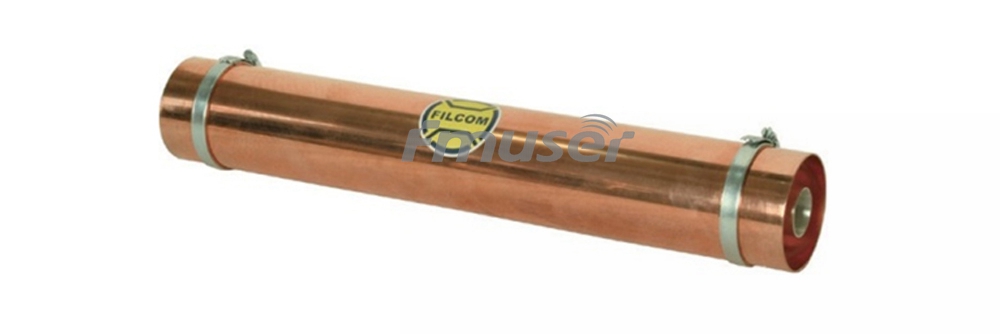
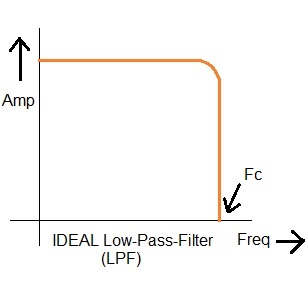
Low pass filters come in various different forms. The main application of this filter is the suppression of the RF amplifier’s harmonics. This characteristic is important since it helps in preventing unwanted interferences when it comes to various transmission bands. Mainly, the low pass filters are utilized in audio applications and filters out noises from any external circuit. After the high-frequency signals are filtered, the resulting signal frequencies get a crisp and clear quality.
- High Pass Filter - Highpass Filter - HPF
As opposed to the low pass filter, the high pass filter (HPF) only allows the high-frequency signal to pass through. In truth, the high pass filters are quite complementary to the low pass filters as both of them can be used in conjunction to produce a bandpass filter. The design of the high pass filter is straightforward and attenuates the frequencies that are lower than a threshold point.
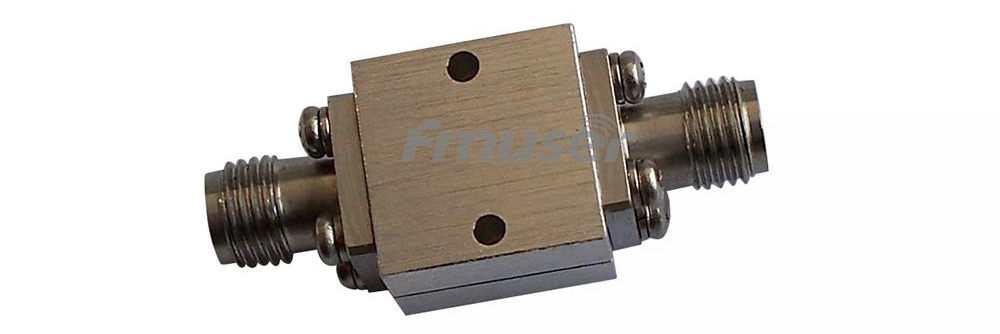
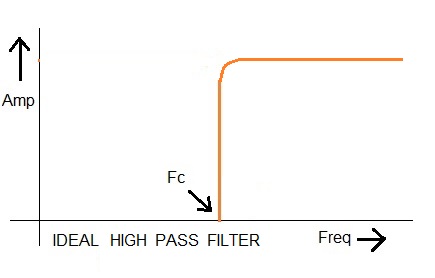
Usually, the high pass filters are utilized in the audio systems through which all the low frequencies are filtered out. In addition, it is used to remove bass in small speakers, and in many cases; these filters are specifically built into the speakers. However, if it comes to any DIY project, the high pass filters can be easily wired into the system.
- Band Pass Filter - Bandpass Filter - BPF
A bandpass filter (BPF) is a circuit that allows signals from two different frequencies to pass through and attenuates the signals that do not come within its acceptance range. Most of the bandpass filters depend on any external power source and utilize active components, i.e. integrated circuits and transistors. Such kinds of filters are called active bandpass filters. On the other hand, some band pass filters utilize no external power source and rely heavily on passive components, i.e. inductors and capacitors. These filters are known as passive bandpass filters.
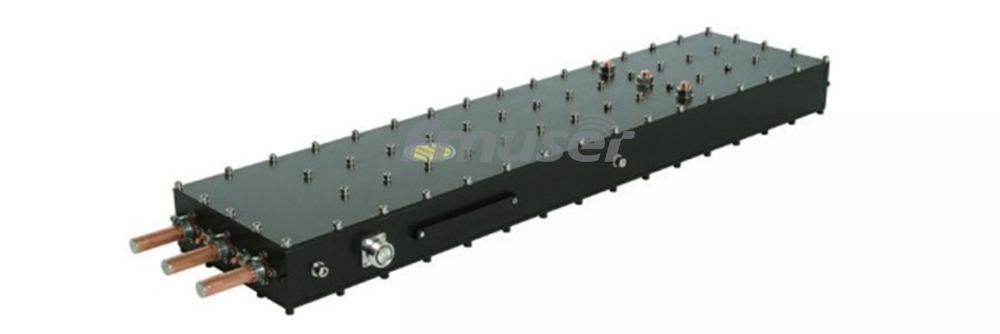
Band pass filters are commonly utilized in wireless receivers and transmitters. Its main function in a transmitter is to limit the output signal’s bandwidth to the minimum so that the necessary data can be conveyed at the desired speed and form. When it comes to the receiver, the band pass filter allows only a desirable amount of frequencies to be decoded or heard, while cutting other signals coming in from unwanted frequencies.
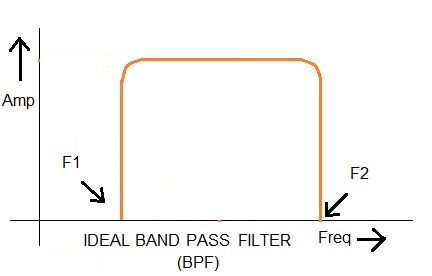
All in all, when a bandpass filter is well-designed, it can easily maximize the quality of the signals, while at the same time, it can minimize the competition or interference among signals.
- Band Reject Filter - Band Stop Filter - Reject Filter - BSF
Sometimes known as band stop filter (BSF), band reject is a filter that allows most of the frequencies to pass through unaltered. However, it attenuates such frequencies that fall below a very specific range. It functions exactly in the opposite manner to that of the bandpass filter.
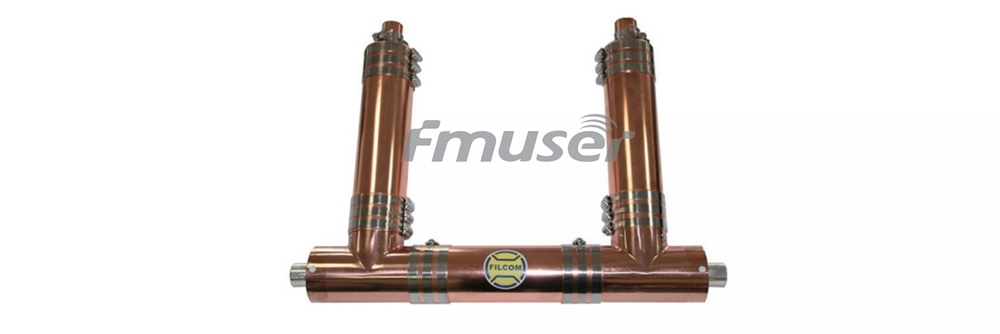
Basically, its function is to pass through the frequencies from zero to the first cut-off point of frequency. In between, it passes all the frequencies that are above the second cut-off point of the frequency. However, it rejects or blocks all the other frequencies that are in between these two points.
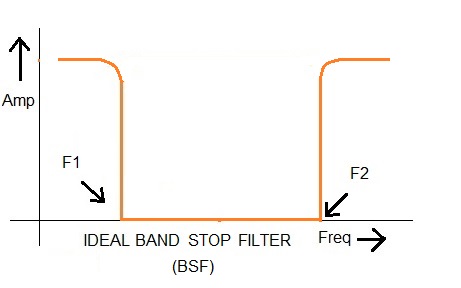
All in all, a filter is something that allows signals to pass through with the help of the passband. That said, the stopband in the filter is the point where certain frequencies are rejected by any filter. Be it high pass, low pass, or bandpass, the ideal filter is the one that exhibits no loss in the passband. However, in reality, there is no such thing as an ideal filter as the bandpass will experience some frequency loss and it is not possible to attain infinite rejection when it comes to the stopband.
▲ Interesting Facts about RF Filters ▲
▲ Back to Content ▲
-
![FMUSER 1400-1700 MHz Digital 3kW Bandpass Filter Compact L-band Band Pass Filter with Dual-mode Waveguide Cavities for RX TX System]()
Price(USD):Ask for a quotation
Sold:8
-
![FMUSER 470-862 MHz 20000W UHF Bandpass Filter 20kW Compact Band Pass Filter With Custom Bandwidth for TX RX System]()
Price(USD):Ask for a quotation
Sold:31
-
![FMUSER 470-862 MHz 5500W UHF Bandpass Filter 5.5kW Digital TV DTV Band Pass Filter With Coaxial Cavities for TX RX System]()
Price(USD):Ask for a quotation
Sold:12
-
![FMUSER 470-862 MHz 3000W UHF Bandpass Filter 3kW Digital TV DTV Band Pass Filter With Coaxial Cavities for TX RX System]()
Price(USD):Ask for a quotation
Sold:16
-
![FMUSER 470-862 MHz 1600W UHF Bandpass Filter 1.6kW Digital TV DTV Band Pass Filter With High Frequency Selectivity for TX RX System]()
Price(USD):Ask for a quotation
Sold:16
-
![FMUSER 470-862 MHz 750W UHF Bandpass Filter 750W Digital TV DTV Band Pass Filter With Tunable Frequency for TX RX System]()
Price(USD):Ask for a quotation
Sold:23
-
![FMUSER 470-862 MHz 350W UHF Bandpass Filter 350W Digital TV DTV Band Pass Filter With Custom Bandwidth for TX RX System]()
Price(USD):Ask for a quotation
Sold:14
-
![FMUSER 167-223MHz 10000W VHF Bandpass Filter 10kW VHF Band Pass Filter With Coaxial Cavities for TX RX System]()
Price(USD):Ask for a quotation
Sold:25
-
![FMUSER 167-223MHz 5000W VHF Bandpass Filter 5kW VHF Band Pass Filter With Tunable Frequency for TX RX System]()
Price(USD):Ask for a quotation
Sold:17
-
![FMUSER 167-223MHz 3000W VHF Bandpass Filter 3kW VHF Band Pass Filter With Tunable Frequency for TX RX System]()
Price(USD):Ask for a quotation
Sold:29
-
![FMUSER 167-223MHz 1500W VHF Bandpass Filter 1500W VHF Band Pass Filter With Tunable Frequency for TX RX System]()
Price(USD):Ask for a quotation
Sold:30
-
![FMUSER 167-223MHz 500W VHF Bandpass Filter 500W VHF Band Pass Filter With Coaxial Cavities for TX RX System]()
Price(USD):Ask for a quotation
Sold:24
-
![FMUSER 87-108MHz 10000W FM Bandpass Filter 10kW FM Band Pass Filter With Custom Bandwidth for Transmitter System]()
Price(USD):Ask for a quotation
Sold:18
-
![FMUSER 87-108MHz 5000W FM Bandpass Filter 5kW FM Band Pass Filter With Coaxial Cavities for FM Radio Antenna System]()
Price(USD):Ask for a quotation
Sold:17
-
![FMUSER 87-108MHz 3000W FM Bandpass Filter 3kW FM Band Pass Filter With Tuneable Frequency for FM Radio Antenna System]()
Price(USD):Ask for a quotation
Sold:24
-
![FMUSER 87-108MHz 1500W FM Bandpass Filter 1.5kW FM Band Pass Filter With Tuneable Frequency for FM Radio Station]()
Price(USD):Ask for a quotation
Sold:35
-
![FMUSER 500W FM Bandpass Filter Low VSWR 87-108MHz Frequency Tuneable FM Band Pass Filter for TX RF System]()
Price(USD):Ask for a quotation
Sold:15
-
![FMUSER 10kW VHF Bandstop Filter 167-223 MHz 10000W Band Stop Filter High Power VHF Band Reject Filter VHF Notch Filter for TX RX System]()
Price(USD):Ask for a quotation
Sold:11
-
![10kW VHF Low Pass Filter 167-223 MHz Coaxial Lowpass Filter with Different Frequency and Power Level for TX RX System]()
Price(USD):Ask for a quotation
Sold:34
-
![20kW FM Low Pass Filter 87-108 MHz FM Broadcast Low Pass Filter for FM Transmitter and Broadcast Stations]()
Price(USD):Contact Us
Sold:51
What You Need to Know About 20kW FM Low Pass Filter
The Next Part is Electrical Index of FMUSER 20kW Low Pass Filter | Skip
Geez, there are too many things you need to pay attention to! However, as a radio station operator, you certainly know more than FMUSER do, but here, in order to protect and optimize your radio station equipment, FMUSER still needs to put forward three suggestions for you, after you buy this 20kW FM low pass filter, three things you need to know: operation, installation, and cable TV.
1. Operation of the RF Filter
This low pass filter is designed to reduce and in most cases eliminate television interference caused by harmonic energy created within FM transmitters.
The filter is bi-directional meaning it can be installed in either direction. The 20kW FM transmitter filter model A exhibits an attenuation to frequencies above 140 MHz as shown in the response curve below.
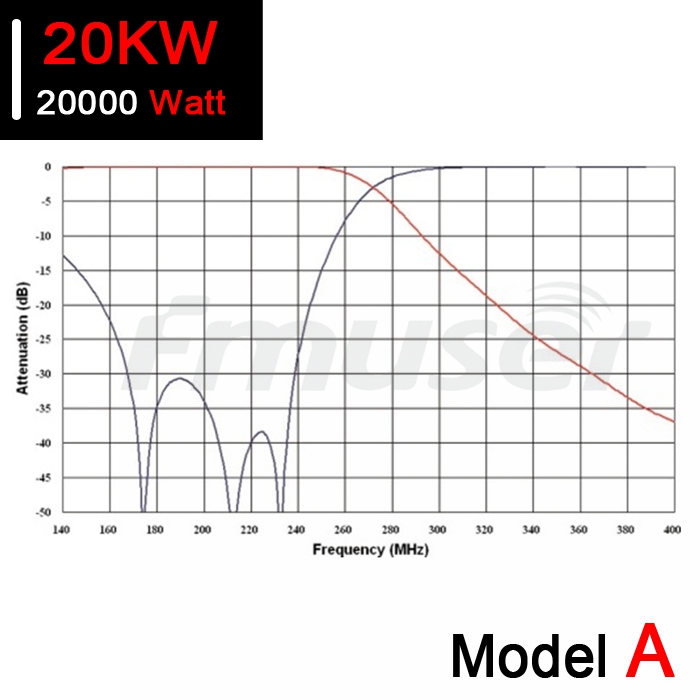
NOTICE: The input signal for the 20kW filter should NOT exceed 20000 watts. Use on higher powers can permanently damage the filter and will void the warranty.
2. Installation of the RF Filter
- The filter should be installed as close to the output of the transmitter as is practical
- Using 3 1/8" EIA connectors with male connectors on either end.
CAUTION: THE FILTER MAY GET HOT DURING OPERATION, this is an indication that it is doing its job by dissipating harmonic energy in the form of heat.
3. Complaint from Your Neighborhood Cable TV
If your transmitter is interfering with a cable TV system the problem may not be solved by the use of a low pass filter. Some cable companies which do not carry FM channels on their system may place TV channels in the FM broadcast band. If this is the case, your fundamental frequency (carrier) may be causing the interference and the filter will be ineffective. Contact your local cable company for more information. In some cases, the cable company can solve the problem by replacing the old or worn-out cable.
Electrical Index of FMUSER 20kW Low Pass Filter (Reference Only)
- Best copper and silver-plated brass material, the user experience are promised
- Minimized Length
- Entire FM Band Coverage
- Rugged Built-in Couplers Available
- Extremely Low Insertion Loss and VSWR
- Different frequency ranges are available to be chosen, which improves the broadcast capability
- Different power levels fully meet the needs of multiple scenarios
- Industrial-leading level of low insertion loss and VSWR enhance the broadcast quality for the broadcast station
- High attenuation at 2nd and 3rd harmonic, no need for worrying about the output
- Say what you want, we help with the customization.
- High Rejection through 10th Harmonic
- Etc.
|
Model |
A |
B |
||
|
Configuration |
Coaxial |
Coaxial |
||
|
Frequency Range |
87 - 108 MHz |
167 - 223 MHz |
||
|
Max. Input Power |
20 kW |
10 kW |
||
|
VSWR |
≤ 1.1 |
≤ 1.1 |
||
|
Insertion Loss |
≤ 0.1 dB |
≤ 0.1 dB |
||
|
Attenuation |
2nd harmonic |
≥ 35 dB |
≥ 35 dB |
|
|
2nd harmonic |
≥ 60 dB |
≥ 60 dB |
||
|
Connectors |
3 1/8" |
3 1/8" |
||
|
Number of Elements |
7 |
7 |
||
|
Dimensions |
85 × 95 × 965 mm |
85 × 95 × 495 mm |
||
|
Weight |
~ 8 kg |
~ 4.4 kg |
||
1. Causes behind harmonic and spurious emissions
- A poorly functioning amateur radio transmitter may be the cause of high-power harmonics. It will also affect the radio transmission of other nearby equipment.
- Amplifiers also produce harmonics. As we all know, they will distort the signal waveform, or they are nonlinear to some extent. Poor radio station design will increase harmonic levels. Therefore, you can reduce interference by simply adopting a good platform design.
- Even if the device does not transmit actively, it will produce spurious emissions. This may be due to high-speed signals, noisy power supplies, or other signal problems. If the device is actively transmitting, spurious emission may occur for two reasons:
- The power cord connected to the radio contains high-frequency noise. It causes the power amplifier of the radio to produce certain frequencies.
- Some components on the PCB pick up the fundamental frequency.
NOTICE: Spurious transmission may occur if the transmitter transmits incorrectly outside the correct bandwidth or mode used. In this case, the transmitter generates a splash, which may interfere with other stations tuned to frequencies near the frequency band.
2. How to Reduce the Impact of Harmonics and Spurious Emission?
The following steps can be taken to control the interference level:
- Check the transmitter to reduce off-frequency spurious emission.
- Make sure noisy equipment and assemblies are away from the antenna.
- Avoid using amateur radio transmitters with poor functions.
NOTICE: Harmonic and spurious emissions cannot be avoided but can be reduced to a certain extent. Any harmonic signal outside the designated channel of the transmitter is regarded as spurious transmission. They are usually the result of poorly functioning equipment or environmental interference.
Extra Share on Radio Interference
The following is an additional radio knowledge sharing on what radio interference is and how to reduce the impact of radio interference. We believe that there has previously been enough information on RF filters, but some radio signal transmission and reception problems still exist in real life. Many customers in the radio field spit bitterly on radio interference and asked us to formulate special solutions for them. Thus, we will briefly describe some practical knowledge about radio interference in the remaining hundreds of words
1. What Type of Equipment Can be Affected by Radio Interference?
Both radio and non-radio devices can be adversely affected by radio signals. Radio devices include AM and FM radios, televisions, cordless telephones, and wireless intercoms. Non-radio electronic equipment includes stereo audio systems, wired telephones, and regular wired intercoms. All of this equipment can be disturbed by radio signals.
2. What Can Cause Radio Interference?
Interference usually occurs when radio transmitters and electronic equipment are operated within close range of each other. Interference is caused by:
- Incorrectly installed radio transmitting equipment;
- An intense radio signal from a nearby transmitter;
- Unwanted signals (called spurious radiation) generated by the transmitting equipment; and
- Not enough shielding or filtering in the electronic equipment to prevent it from picking up unwanted signals.
3. What Can You Do?
- Try to prevent interference problems before they happen. Consult with municipal authorities to find out what regulations apply to antennas and tower structures. When you have an installation plan that meets municipal requirements, speak to your neighbors. Explain what you want to do and why. Assure them that you will do your best to prevent any problems. Remind them that GRS and amateur radio operators often perform an important public service by assisting local authorities during emergencies and large public events.
- Make sure your equipment is installed correctly. The radiostation’s antenna should be as far away from neighboring houses as possible and away from power lines which could affect its operation. Read carefully the section, Installing Your Radio Station.
- Operate your station with your neighbors in mind. Limit transmitter power, where possible, to the minimum level required for adequate communications. For GRS stations where transmit, power amplifiers are not permitted, the maximum output to the antenna should not be more than 4 watts (single sideband;12watts peak).
- Make sure your equipment is maintained in good condition according to its technical requirements. From time to time, you should verify that the transmitting frequency is correct, the bandwidth is within operating limits, and the station’s cables, antenna, and ground system are in good condition.
4. You Also Should:
- Be sensitive to interference problems and try to solve them as quickly as possible.
- Work with your neighbors to find out what’s causing the problem and what makes it better.
- While you are trying to find a technical solution for the interference, restrict your transmitter power and operating times. Consider shutting your station down altogether until the problem is corrected.
- Feel Free to ask us if you're confronting more problems
CONTACT US


FMUSER INTERNATIONAL GROUP LIMITED.
We are always providing our customers with reliable products and considerate services.
If you would like to keep touch with us directly, please go to contact us
